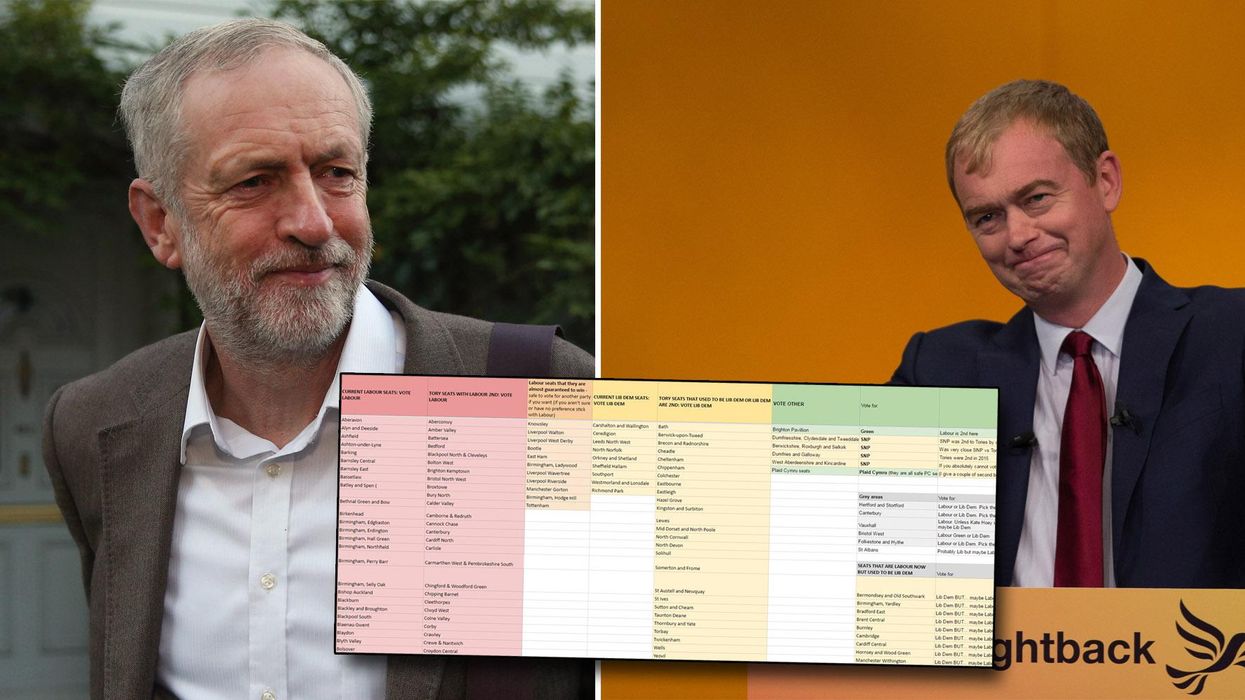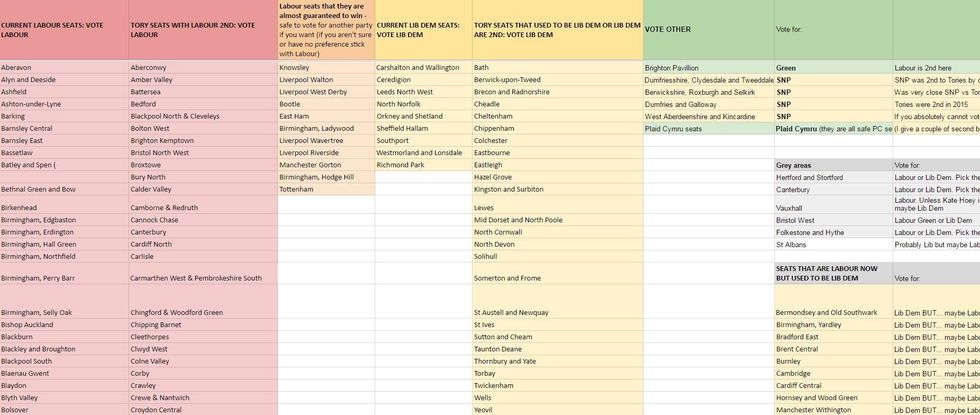Louis Dor
Apr 19, 2017

Picture:
Getty/@chickabiddybex/edited by indy100
People are sharing a spreadsheet that encourages people to vote tactically to deny the Conservatives a victory in the likely 8 June election.
When Theresa May first called for a snap general election, she argued that:
division in Westminster will risk our ability to make a success of Brexit.
which appears to suggest a Parliamentary opposition is a bad thing for the country (it isn't).
The real reason is plainly that Jeremy Corbyn has been consistently behind in the polls and she thinks she can gain an overwhelming mandate to lead in a landslide election victory.
People have seized on the moment as an opportunity to pounce on what they deem as overconfidence from the conservative party.
A guide to voting tactically, in order to kick out Conservative MPs, was created by Becky Snowden (aka @chickabiddybex), and tweeted.
Becky, 28, from West Yorkshire, who cites Barack Obama as an inspiration for her political activism and interest, told indy100:
I have always been really disappointed with our voting system. It isn’t fair.
If you live in some constituencies you often only have a choice of one or two candidates because there is no way any others could get in.
Or even worse – you could live in a “safe” seat where it doesn’t matter who you vote for at all, the incumbent will win.
This means one person’s vote is not equal to another’s.
Some people’s votes matter and others don’t. But the parties in power won’t change it because it keeps them in power. That sentence horrifies me.
She cited a number of examples where votes do not equal constituencies:
In what world is it a democracy when a party gets 23 per cent of the vote and only 9 per cent of the seats. This was the Lib Dems in 2010. Labour got 29 per cent of the vote but ended up with 40 per cent of the seats. Same story in 2015 with different parties. Lib Dems got 8 per cent of the vote and only 8 seats. The SNP got 5 per cent of the votes and 56 seats. UKIP got 13 per cent of the votes and only 1 seat. The Conservatives only got 36 per cent of the vote but ended up with 51 per cent of the seats.
So she made her Google doc.
It's been widely shared on both Twitter and Facebook.
The document advises you, based on where you live, which party you should vote for, depending who were closest to the Conservatives or who won the seat at the last election.
She explained her selection of which party to vote for in each constituency:
The theory is easy. Find a Tory swing seat and get people to vote for whoever is most likely to beat them. And for some constituencies it was genuinely that simple. For others, the Tory safe seats, it isn’t clear at this time who the best competitor is. Most of the data is based on previous election results in 2015, 2010 and by-elections.
I have also had overwhelming support from people offering local knowledge. I try to take this into account where I can.
The most difficult to call areas I have tried to indicate that people will have to pick those for themselves. I’ve also tried to indicate which seats are safe ''non-Tory' so people can make up their own minds on those.
Becky said of her political allegiances:
I identify most with the Liberal Democrats, however the SNP interest me a lot. I can’t vote for them though, living in England.
Not that I can vote for the Lib Dems either, as my constituency is a Labour/Tory swing seat. I will be voting Labour.
My local MP Paula Sheriff has done a lot for the local community, the NHS and women. If I had a choice of Labour vs Lib Dem I would find it a difficult choice here. But I don’t have that choice.
Which is a very fair perspective to have.
However, this reporter would argue tactical voting introduces a few problems.
Party support changes.
A party did well in 2015. Great. That can mean next-to-nothing in 2017.
This election is a whole new ball game and seats could change hands in any direction. 111 seats changed hands in 2015 in a number of different directions.
You have little way of predicting that your protest vote against a Government will usher in the party you voted for - 50 days is a long time on the campaign trail.
You misrepresent your own views:
You may not be voting for the party of your choice, and when parties are drawing up policy, they look at who people voted for and ask why, they tend not to ask if people voted tactically in those instances. You are in essence telling the politicians in the only way they'll listen, that your views aren't what they actually are.
In addition the party you vote for, and everyone else, will interpret your vote as genuine support, rather than a protest vote - you're strengthening a cause you may not fully support.
If you're voting for simply "left wing and not Tory," you're not voting for a movement or a vision for the country, you're actually diluting your views in a way that will be misinterpreted.
You have no guarantee of getting the coalition you want:
If you're a Labour voter and you vote Liberal Democrat, and they go into coalition with the Tories - congratulations, you've played yourself.
They did it in 2010, Liberal Democrat leader Tim Farron hasn't ruled it out and said he would again.
If you're a Liberal Democrat voter and you vote Labour to oppose the Tories, and Corbyn wins the election with a majority (it's unthinkable at present, but who knows what will happen in 50 days), - congratulations, you've... Oh we used that line already.
Alternatively:
It could work brilliantly, we could end up with a Labour/Liberal Democrat Coalition that the left falls in love with and we know nothing.
But unless you truly believe that those two parties a) will go into coalition with each other and b) will pick and choose the policies you like, you're just another protest voter.
Here's a crazy idea:
Vote for the party and leader your views most align with and encourage others to do the same.
More: The 53 constituencies most likely to change hands in the general election
Top 100
The Conversation (0)














